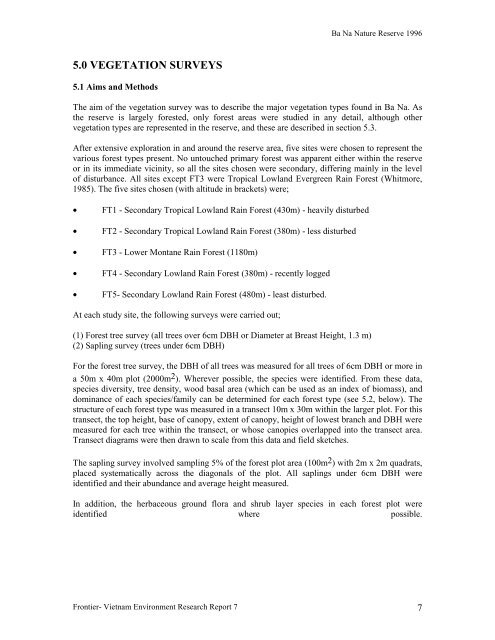Frontier Tanzania Environmental Research - Frontier-publications ...
Frontier Tanzania Environmental Research - Frontier-publications ...
Frontier Tanzania Environmental Research - Frontier-publications ...
Create successful ePaper yourself
Turn your PDF publications into a flip-book with our unique Google optimized e-Paper software.
Ba Na Nature Reserve 1996<br />
5.0 VEGETATION SURVEYS<br />
5.1 Aims and Methods<br />
The aim of the vegetation survey was to describe the major vegetation types found in Ba Na. As<br />
the reserve is largely forested, only forest areas were studied in any detail, although other<br />
vegetation types are represented in the reserve, and these are described in section 5.3.<br />
After extensive exploration in and around the reserve area, five sites were chosen to represent the<br />
various forest types present. No untouched primary forest was apparent either within the reserve<br />
or in its immediate vicinity, so all the sites chosen were secondary, differing mainly in the level<br />
of disturbance. All sites except FT3 were Tropical Lowland Evergreen Rain Forest (Whitmore,<br />
1985). The five sites chosen (with altitude in brackets) were;<br />
• FT1 - Secondary Tropical Lowland Rain Forest (430m) - heavily disturbed<br />
• FT2 - Secondary Tropical Lowland Rain Forest (380m) - less disturbed<br />
• FT3 - Lower Montane Rain Forest (1180m)<br />
• FT4 - Secondary Lowland Rain Forest (380m) - recently logged<br />
• FT5- Secondary Lowland Rain Forest (480m) - least disturbed.<br />
At each study site, the following surveys were carried out;<br />
(1) Forest tree survey (all trees over 6cm DBH or Diameter at Breast Height, 1.3 m)<br />
(2) Sapling survey (trees under 6cm DBH)<br />
For the forest tree survey, the DBH of all trees was measured for all trees of 6cm DBH or more in<br />
a 50m x 40m plot (2000m 2 ). Wherever possible, the species were identified. From these data,<br />
species diversity, tree density, wood basal area (which can be used as an index of biomass), and<br />
dominance of each species/family can be determined for each forest type (see 5.2, below). The<br />
structure of each forest type was measured in a transect 10m x 30m within the larger plot. For this<br />
transect, the top height, base of canopy, extent of canopy, height of lowest branch and DBH were<br />
measured for each tree within the transect, or whose canopies overlapped into the transect area.<br />
Transect diagrams were then drawn to scale from this data and field sketches.<br />
The sapling survey involved sampling 5% of the forest plot area (100m 2 ) with 2m x 2m quadrats,<br />
placed systematically across the diagonals of the plot. All saplings under 6cm DBH were<br />
identified and their abundance and average height measured.<br />
In addition, the herbaceous ground flora and shrub layer species in each forest plot were<br />
identified where possible.<br />
<strong>Frontier</strong>- Vietnam Environment <strong>Research</strong> Report 7 7
















